Supplemental Digital Content is available in the text.
Abstract
Background:
Parallel to the steady decline in surgical aesthetic procedures to the face, dermal fillers seem to have gained a more prominent place in facial rejuvenation over the last couple of years. As a dermal, facial filler, autologous fat transfer (AFT) seems to have real potential because of the biocompatibility of adipose tissue besides being a procedure with few and primarily minor complications. This systematic review aims to evaluate the available evidence regarding the safety and effectiveness of AFT for facial rejuvenation.
Method:
A systematic review after the Preferred-Reporting-Items-for-Systematic-Reviews-and-Meta-Analysis (PRISMA) statement was conducted. MEDLINE, Embase, and Cochrane Library were searched up to December 2016, with no language restrictions imposed. Case series, cohort studies, and randomized controlled trials (RCTs) reporting on relevant outcomes were included.
Results:
Eighteen clinical articles were included, reporting on 3,073 patients in total over a mean follow-up period of 13.9 months. Meta-analysis showed an overall complication rate of 6% (95% CI 3.0–14.0), with hematoma/ecchymosis (5%), fat necrosis/oil cysts (2%), and irregular fat distribution and scars (both 2%) being among the most reported. No major complications were reported, and the overall patient satisfaction rate was 81%.
Conclusion:
Although the evidence in this systematic review is still limited and plagued by heterogeneity between studies, AFT seems to be a promising method in facial rejuvenation with fewer complications than other fillers and high patient satisfaction rates. Further large-cohort, preferably multicenter, RCTs should substantiate these results through quantifiable volumetric assessment tools and validated patient questionnaires, while adhering to predetermined nomenclature in terms of complications.
INTRODUCTION
For ages, the face has been considered the most prominent feature of the human being, and the motivation to alter its appearance for cosmetic purposes is as old as the work of Sushruta.1 Over the past decades, fueled by western media adjusting to the growing older population, there has been an increasing demand for minimally invasive cosmetic procedures that enhance or maintain the youthful-looking appearance of the face.2 The 17% decrease of facial surgical cosmetic procedures since 20003,4 combined with the 6.5% increase of hyaluronic acid, globally in 2015,5 further illustrates the growing demand for dermal fillers. The ideal filler opposes many of the aspects that menace the aging face (sagging, skin-atrophy), while at the same time being predictable, adjustable to facial anatomy and especially biocompatible.6 None of the numerous soft-tissue augmentation products currently approved by the FDA, both temporary fillers and permanent fillers adhere perfectly to these qualities, and complications range from minor (bruising) to severe (embolisms, blindness).7,8 As a result, it was not long before autologous fat transfer (AFT) or lipofilling found its way as a potentially superior facial filler with numerous studies reporting on the promising results besides minimal side effects.9–11 Numerous reviews and articles describing the authors preferred method for facial AFT currently exist,12–26 but they generally lack a comprehensive study design. Furthermore, the abundance of anatomical facial zones further complicates pooling of data, with most authors describing its appliance to 1 or 2 facial regions.10 Therefore, the aim of this systematic review was to determine the rejuvenating properties of AFT to the whole face in terms of volume enhancement and patient/surgeon satisfaction and objectify these terms by determining technique, complications, volume retention, and specific patient/surgeon satisfaction rates.
METHODS
A systematic review of literature reporting on technique, efficacy, and patient/surgeon satisfaction rates regarding AFT for facial rejuvenation was conducted according to the preferred-reporting-items-for-systematic-reviews-and-meta-analysis (PRISMA) statement.27 Medline (Ovid), Embase.com, and Cochrane Library (Wiley) were searched from inception (by JG and TK) up to December 11, 2016. The following terms were used (including synonyms and closely related words) as index terms or free-text words: “facial” and “rejuvenation” or “aging” or “wrinkles” and “Autologous-Fat-Transfer.” The full search strategies can be found in the supplementary information (see Appendix, Supplemental Digital Content 1, which displays the search strategy for Pubmed, http://links.lww.com/PRSGO/A628). Studies that were considered relevant based on the titles were stored using Endnote (Clarivate Analytics),28 with no restriction on language, study design, or publication media. Bibliographies of relevant articles were manually searched for relevant or missed references.
Eligibility Criteria
Original randomized controlled trials (RCTs) and cohort studies on facial rejuvenation with the use of AFT with or without supplementation, which reported on efficacy (ie, volume enhancement, improving skin trophicity, and decreasing wrinkles), technique, and patient/surgeon satisfaction, were included. Studies reporting on AFT for facial rejuvenation in conjunction with/or following other surgical procedures or injectables were excluded. However, studies combining AFT with laser-resurfacing techniques or studies that included combinations of treatment (ie, AFT + surgical procedures) but clearly reported on AFT-specific complications were included. Duplicate articles, case reports, or case series with a sample size <10 and articles with a mean follow-up period <6 months were excluded.
Study Selection
Articles were screened for relevancy by 2 independent reviewers (JG, TK). When considered eligible by both reviewers, the full-text article was retrieved for possible inclusion. Discrepancies between the 2 reviewers were discussed and when a solution was not found, a third reviewer (JH) was consulted. When a study could not be retrieved, the authors were contacted to request a copy of the original article.
Outcome Measures
We included the following outcomes:
facial rejuvenating properties (ie, volume enhancement, improving skin trophicity, decreasing wrinkles) objectified in numerical (ie, percentile) or ordinal scale
complications
patient/surgeon satisfaction.
Data Extraction
Data were extracted by 1 researcher (JG) using standardized tables developed for this purpose and checked by a second reviewer (TK). Extracted data included the following: country, publication year, study design, number of subjects, AFT technique, complication rate and management, volumetric measurements, and satisfaction rates. Included studies were evaluated with respect to the following factors: inclusion/exclusion criteria, patient selection (ie, consecutive versus nonconsecutive recruitment), and use of objective outcomes. Included studies were assigned a level of evidence (OCEBM, 2011) by 2 independent reviewers (JG, TK). The principal summary measures are rates or actual numbers with percentages given between parentheses, besides means over follow-up periods.
Assessment of Risk of Bias
Observational studies and clinical trials without detailed randomization protocols were considered studies with high risk of bias. The Cochrane Risk of Bias for Randomized Clinical Trials29 and Risk-Of-Bias-In-Non-randomized-Studies-of-Interventions (ROBINS-I)30 were used for quantifying the risk of bias across RCTs and non-RCTs respectively.
Data Synthesis
In accordance with the Cochrane Handbook for Meta-analyses, in the studies that compared 2 methods, only the data from the group treated with AFT was used.31
Statistical Analysis
R statistical software was used for analyzing the data.32 The pooled proportion of complications was estimated by both a fixed and random-effects model. The amount of heterogeneity between the studies was tested with Cochrane’s Q and quantified with I2. A random-effects model was used if Q was significant, a fixed effects model otherwise.33,34
RESULTS
There was a high interrater agreement, in selecting relevant articles based on the abstract screening, of 0.88. After screening (Fig. 1), a total of 18—English written—articles were included. The risk of bias across the cohort studies (Table 1) was considered moderate in 80%. The risk of bias of the 3 comparative studies is illustrated in Figure 2. Extracted data are summarized in Tables 1–5. The included studies were published between 1990 and 2016, with 13 retrospective and 2 prospective cohort designs next to 3 trials. There were 17 level-III studies and 1 level-II study involving a total of 3,073 patients. Two studies35,36 studied the same set of patients by applying different methods of preparation or supplementation respectively using 2 different sides of the face (split over a vertical axis). The mean follow-up period was 13.9 months (range: 9–133).
Fig. 1.
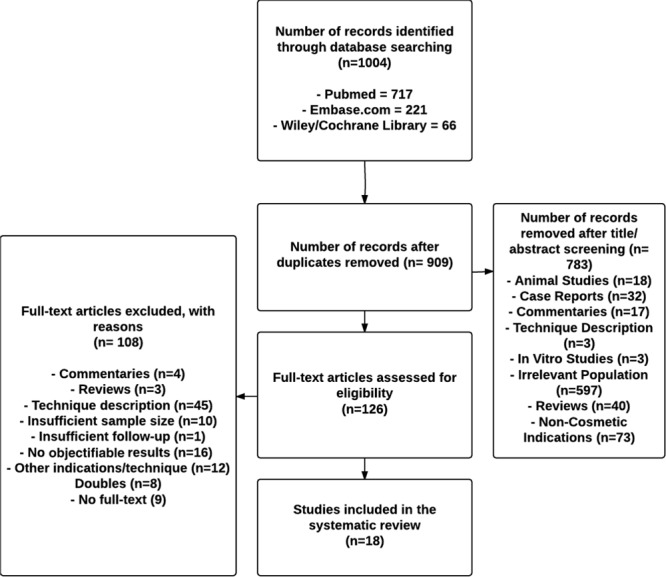
Flow diagram illustrating systematic inclusion of studies for systematic review.
Table 1.
Baseline: Characteristics of Included Studies

Fig. 2.
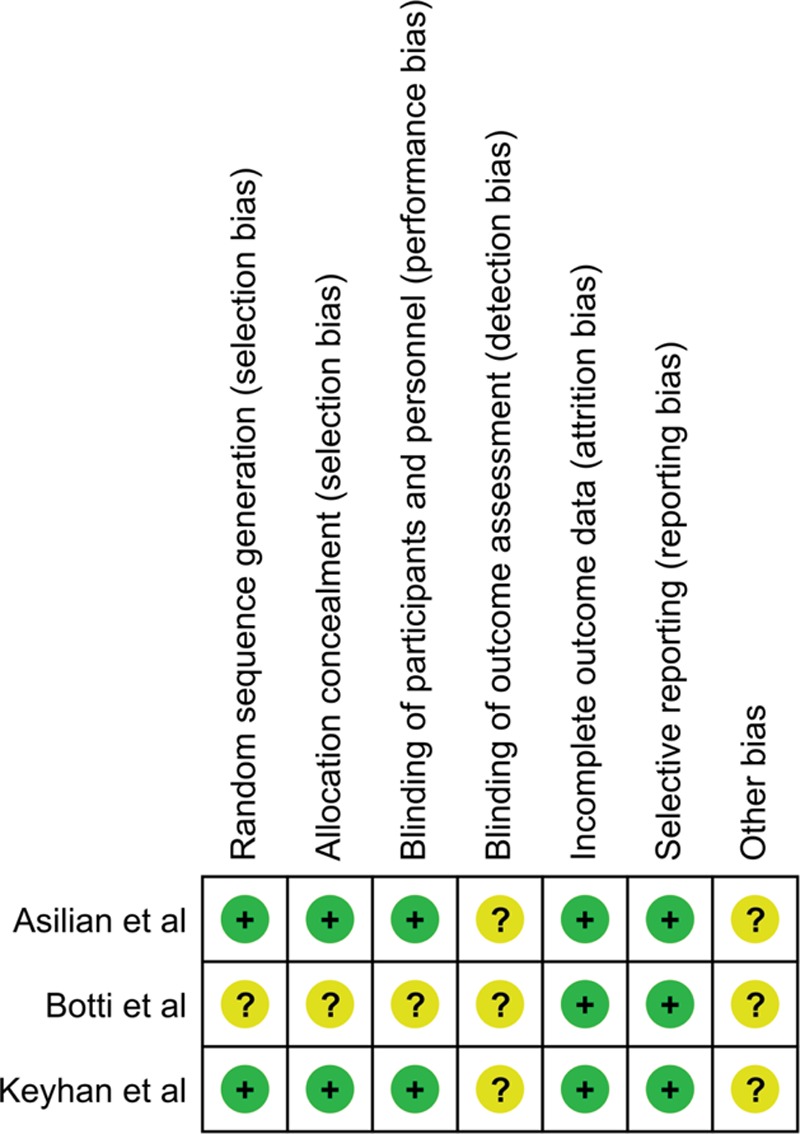
Risk of bias in studies with a comparative study design.
Table 5.
Patient/Surgeon Satisfaction
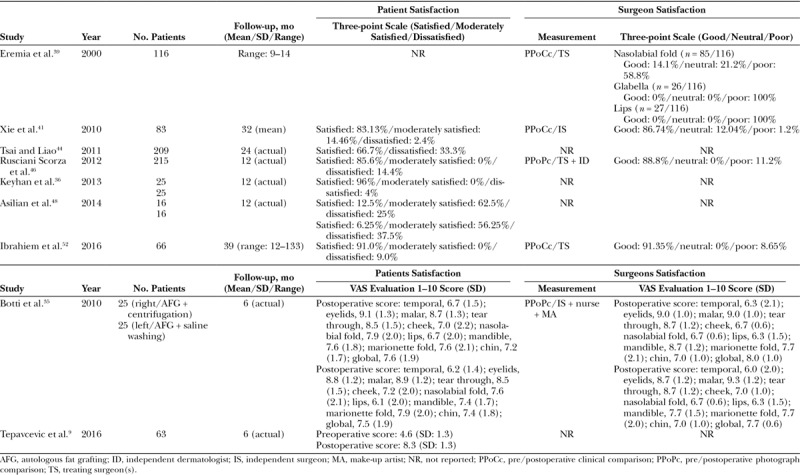
Table 3.
Complications: Overview of Complications and Management
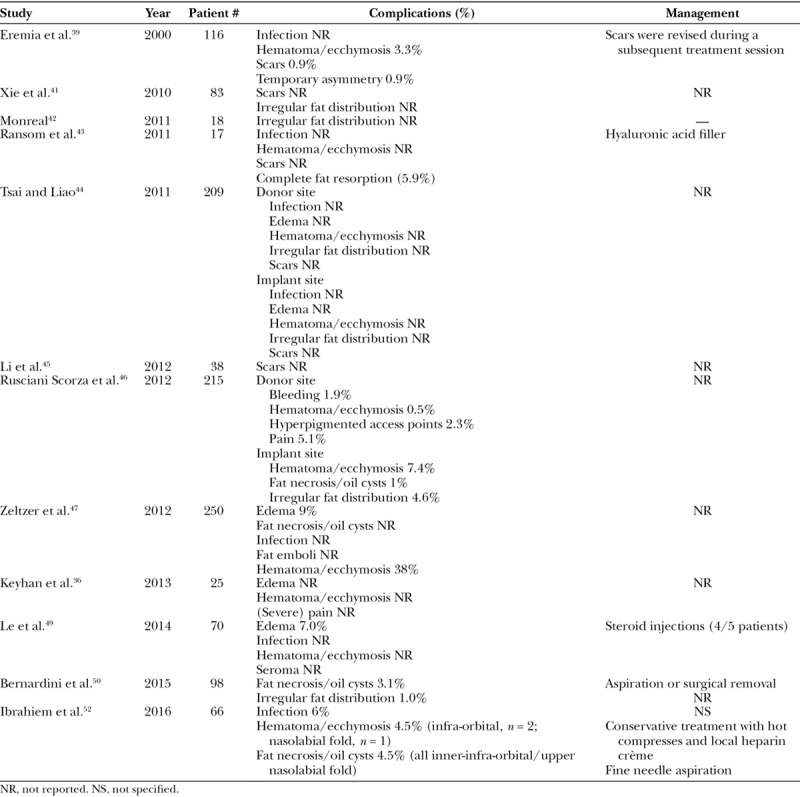
Fat Grafting Technique
All articles described, to some extent, the methods of preparing and grafting the adipose tissue (Table 2).9,35,36,38–52 Eleven out of 14 studies used a local form of anesthesia,9,36,38–42,44–46,48,49,51,52 and 3 authors preferred general anesthesia.35,47,50 The abdomen was the primary donor site in most studies with fat from the thigh and flank area used in cases of insufficient supply. The infiltration cannula size was poorly reported, with 3 studies35,40,46 reporting using 1-, 2-, or 3-mm cannulas, respectively, and the infiltration solution varied widely among studies. Ten studies9,35,40,41,45–50 (additionally) used some form of local anesthetic in combination with different solutions of epinephrine and saline before harvesting by way of manual aspiration in 16 of the 18 reporting studies. Harvesting was done by 2–3 mm cannulas, mostly blunt with 2–3 holes and attached to 10–60 ml Luer lock syringes. Preparation of the adipose tissue was done solely by centrifugation in 5 studies9,36,44,45,50 ranging from 1,000 to 3,000 rpm over 1–3 minutes spans, with the studies of Asilian et al.48 and Botti et al.35 comparing centrifugation and washing between groups. Furthermore, 6 studies38–41,43,51 used combinations of preparations in a none-comparative study design. Stromal vascular fraction (SVF), platelet-rich fibrin (PRF), and platelet-rich plasma (PRP) were used to supplement the fat in 4 studies, 2 by comparative design.36,45 The injection cannula sizes ranged from 1 to 3 mm (14–23 gauge) and were mostly blunt with 2 studies reporting using lateral openings35,48 and 1 study using a ratchet gun for precise fat distribution.46 For the injections, most studies described a retrograde injection technique. The primary site of injection was the subcutaneous space with additional injections most often performed above or just beneath the superficial muscular aponeurotic system (SMAS). The number of AFT sessions was reported in 11 studies9,36,39–41,45–47,49,51,52 and varied from 1 to 4 with an mean interval of 4.25 months.39–41,47,49,52 Postoperative management varied greatly among the 9 reporting studies35,39,41,43–46,48,52 and was even contradictory with Ibrahiem et al.52 recommending massage, as opposed to other studies.
Table 2.
Fat Grafting Technique: Overview of the Form of Anesthesia, Donor Site, Infiltration Solution, Harvesting, Preparation, and Injection Technique Used
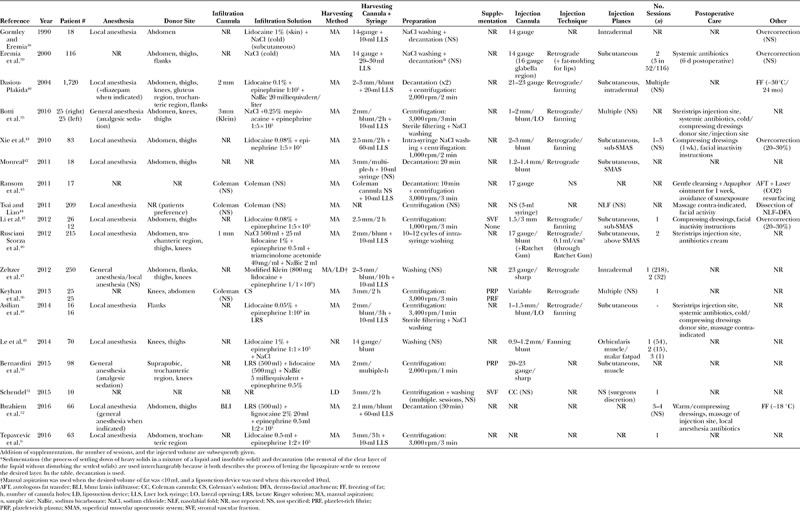
Complications
Meta-analysis was performed over the 12 reporting studies.36,39,41–47,49,50,52 To determine the amount of heterogeneity between studies, Cochran’s Q was calculated (101.45, P < 0.0001) and quantified with I2 (tau2 = 2.0747; H = 3.81 [2.98, 4.87]; I2 = 93.1% [88.7%, 95.8%]). According to the Cochrane’s Handbook for Systematic Reviews of Interventions53—in the case of between-trial heterogeneity—the random-effects meta-analysis weights the studies relatively more equally and is therefore used in the following description. The overall complication rate was 6% (95% CI: 3.0–14.0) after a mean follow-up of 15.8 months in 1,205 patients (see Tables, Supplemental Digital Content 2, which displays different data charts including overall complications and infections, http://links.lww.com/PRSGO/A629). Hematoma/ecchymosis most reported (5%, 95% CI: 2.0–15.0), followed by fat necrosis/oil cysts (2%, 95% CI: 1.0–5.0), irregular fat distribution and scars (both 2%, 95% CI: 1.0–4.0). Infections were reported in 1% (95% CI: 0.0–4.0) of 728 patients in 6 studies.
Volume Retention
Objective measurements of the volumetric result are imperative to demonstrate the efficacy of AFT. However, the face consists of multiple anatomical units greatly varying in important features like density causing great heterogeneity in comparing results. Five studies36,38,40,45,51 were included in the volumetric analysis (Table 4). The methods of determining volume retention varied greatly between studies. Supplements added to the fat graft were reported in 3 studies. As great heterogeneity between studies in regard to injection site and volumetric assessment exists, no pooling of data could be achieved, and volume retention varied greatly from 13% to 68% over a mean of 12.2 months.
Table 4.
Injected Volume Per Facial Region and Retention
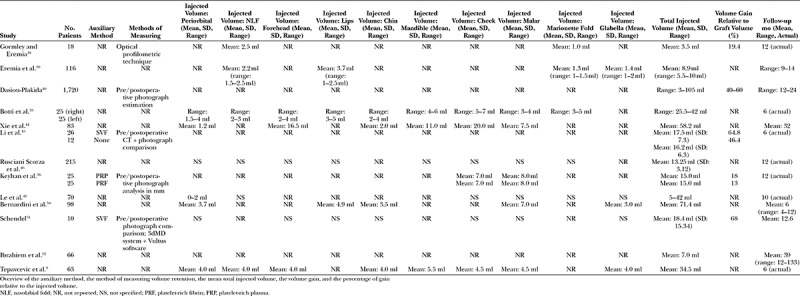
Patient/Surgeon Satisfaction
A total of 9 studies9,35,36,39,41,44,46,48,52 reported on patient and/or surgeon satisfaction either on a visual analog scale (VAS) or a 2-4 point Likert scale (Table 5). Meta-analysis for patient satisfaction was performed after conversion to a dichotomous scale (see Tables, Supplemental Digital Content 3, which displays patient satisfaction results, http://links.lww.com/PRSGO/A630). To account for between-trial heterogeneity (Cochran’s Q: 35.26-6<0.0001/I2: tau2 = 0.4391; H = 2.42 [1.72, 3.41]; I2 = 83.0% [66.3%, 91.4%]), the random-effect model was used for reporting patient satisfaction. Furthermore, overall scores were used only postoperatively, and when satisfaction rates were compared between study groups,48 a mean over the total cohort was calculated. The satisfaction rate over a total cohort of 630 patients in 6 studies36,41,44,46,48,52 was 81% (95% CI: 70.0–89.0). It should be noted that Asilian et al.48 compared 2 groups of patients according to preparation method (centrifugation vs filtering/washing), and both groups were included in the analysis. Surgeons reported a good cosmetic outcome in 89%, and the overall postoperative mean VAS score among 88 patients in 2 reporting studies9,35 was 79.5.
DISCUSSION
This study was performed to obtain a comprehensive overview of the available evidence on the outcomes of AFT in facial rejuvenation with objective outcome measures and a clear description of the technique applied. The first remarkable issue is the small number of studies to evaluate AFT in rejuvenation of the face. Although AFT is used widely all over the world, the number of well-designed studies is limited.
As is the case in AFT for other indications—such as the breast—the techniques used for harvesting, preparation, and reinjection of the fat varied greatly among authors. The most important aim in this continuing search for the golden standard in AFT is improving the volume retention, which is believed to be influenced by almost all the AFT aspects. Whether shear stress of the adipocytes caused by cannula size (either during harvesting or injection) or high osmolality of the infiltration solution plays a role remains a matter of debate. Both have been shown to vary greatly in this systematic review but have also been shown to matter significantly to the long-term volume retention.54 Two recently published in vitro studies55,56 shed some light on this interesting topic with Hivernaud et al.56 reporting on—among others—adipose tissue resorption variances between different combinations of harvesting (ie, manual, power-assisted, or water-assisted lipoaspiration) and preparation (ie, decantation, centrifugation, or filtration). They found that both in the in vitro and in the murine models, greater efficiency (in terms of retaining tissue volume) was achieved with manual aspiration, soft centrifugation (400 g for 1 min), and washing steps. Although the majority of studies in this systematic review used manual aspiration, the centrifugation settings and times were considerably higher. Secondly, Streit et al.55 further studied the differences in morphology between fat samples obtained through decantation, centrifugation, and membrane-based tissue filtration and found the highest numbers of adipose-derived stem cells in the upper fraction of centrifuged lipoaspirates but the maximal concentration of adipose fraction after membrane-based tissue filtration. In conclusion, both studies seem to suggest superiority of manual aspiration and centrifugation and/or washing procedures—in line with both the British and German clinical guidelines57,58—but longer follow-up for the former, and affirmation in clinical practice for the latter study is necessary to make conclusive statements. As was stated in the recent systematic review of Shim et al.,59 the same can be said for harvest location, because multiple studies have shown a great varying degree in adipocyte number, volume, and morphology and also adipocyte-derived stem cells depending on where the fat is harvested.
Complications after dermal fillers are usually divided into early and late events and again into minor and major.8 One of the advantages of AFT over other facial fillers in both early and late events is the absence of hypersensitivity reactions and granuloma formation, respectively. Furthermore, when comparing AFT with the use of hyaluronic acid (HA) fillers, major complications such as necrosis and blindness—which have both been described after HA injection60–63—were not reported. The most reported complication after AFT for facial rejuvenation—hematoma/ecchymosis—was reported in 5% (95% CI: 2.0–15.0) of the total cohort, which is in line with that reported in studies using other dermal fillers.64 Late onset complications such as fat necrosis (2.0%, n = 629) have been reported but are among the other complications10,11 minimal.
As stated before, the long-term volume retention is crucial in defining AFT as a biocompatible permanent filler in general and in verifying its superiority over other fillers. Three studies40,45,51 reported an overall volume retention ranging from 40% to 68% over a follow-up of 6 to 12 months without specifying the injected locations. The remaining studies36,38 while specifying the locations (nasolabial/marionette fold and cheek/malar, respectively) reported much lower volume retentions, ranging from 13% to 19% over a follow-up of 12 months indicating the importance of the location in regard to the long-term retention of the reinjected fat. However, because of the great heterogeneity among studies—especially when it comes to the different injected facial zones—no definitive conclusion could be made with regard to overall volume retention after AFT for facial rejuvenation. Supplements were used in 2 studies that reported on volume retention36,51; however the injected facial zones, the method of measuring volume retention, and the supplements used (PrP/PrF vs SVF) all varied, so no beneficial effect could be reported. Therefore, the aim of further studies should be toward facial location-specific volumetric assessment using objectifiable tools like 3D imaging (such as the VECTRA XT 3D imaging system), CT, or MRI.
The patient and surgeon satisfaction rates in the included studies were considered acceptable and in line with other publications and a recently published study on quality of life after minimally invasive facial cosmetic procedures.65 However, only standard visual analog scales, and also Likert scales, were used without the inclusion of validated questionnaires like the FACE-Q.66 Also satisfaction scores per facial zone are only reported in 1 study35 on VAS, ranging from 6 in the lips to 9 in the eyelids and malar region. Therefore, further studies should focus on incorporating the FACE-Q into the study design and report per facial zone.
Limitations
This systematic review has several limitations. Only low-level evidence studies (OCEBM III) and mainly retrospective studies without a control group were found. The 3 studies that used a comparative study design failed to report on some important aspects like allocation concealment and blinding, as is illustrated in Figure 2. The use of validated measurement tools to assess patient-reported outcomes is lacking, and objectifiable data on volume retention are generally absent. Heterogeneity between studies in reported outcomes and nomenclature regarding specific facial zones and complications makes it difficult to draw conclusions. This was partly resolved by combining similar terms under 1 common nominator (eg, bruising and ecchymosis), but this may have introduced some bias. More important is the fact that several studies neglected to specify the complications and only sufficed with the annotation that there were none. These studies67,68 were therefore excluded, and this adds further to a possible reporting bias. Finally, the very definition of a complication of AFT in facial rejuvenation is a complicated matter and a clear consensus whether, for example, postoperative pain qualifies as a complication or part of the normal postoperative course is still lacking. A strong example thereof is the 38% rate of hematoma in the study of Zeltzer et al.,47 which deviates significantly from the reported rate in the rest of the studies, and while the authors tried to correct this by using a random-effect model, the reader should be cautious in interpreting these results. Therefore, on a methodological basis, the focus for further studies should be, first, to define complications and, second, to adhere to this definition when reporting on complications. In reporting on patient/surgeon satisfaction, the authors took certain liberties in translating Likert scales to dichotomous (satisfied vs dissatisfied) data by categorizing “moderately satisfied”—in a 3-point Likert scale—under “satisfied,” because the patients might answered differently when presented with an actual dichotomous question. This should be kept in mind when interpreting these results.
The aim of this study was to complement the broad database of descriptive reviews and expert opinions on the subject of AFT for facial rejuvenation with the addition of a more comprehensive, systematically reviewed overview of the recent literature, including meta-analysis of complications and satisfaction. The authors believe this systematic review accomplishes that by the inclusion of structured tables on important outcomes and also the exclusion of case series and case reports and studies with insufficient follow-up periods.
CONCLUSIONS
This systematic review provides an updated overview of the important outcomes of AFT for facial rejuvenation. Although the evidence in this review is still limited and plagued by the same heterogeneity that is often found in reporting on AFT for other indications, still, this technique is regarded as a promising method in facial rejuvenation. Although AFT has a number of obvious advantages over other dermal fillers in terms of biocompatibility, such as the absence of hypersensitivity reactions and the risks of granuloma formation, other complications such as fat necrosis have to be taken into account. Furthermore, the great variation in reported volume retentions in this systematic review suggests further studies are needed to clarify the facial-unit-specific, long-term preservation of the achieved volume before AFT can rightfully be called a true permanent filler. However, in achieving these goals, proper research should evaluate whether AFT is the superior biocompatible next-generation facial filler.
ACKNOWLEDGMENT
The authors would like to thank Mr. Quinten de Bakker, from the medical library, VieCuri Medical Center, Venlo, the Netherlands for his widespread assistance in the search process.
Supplementary Material
Footnotes
Disclosure: The authors have no financial interest to declare in relation to the content of this article. The Article Processing Charge was paid for by the authors.
Supplemental digital content is available for this article. Clickable URL citations appear in the text.
REFERENCES
- 1.Champaneria MC, Workman AD, Gupta SC. Sushruta: father of plastic surgery. Ann Plast Surg. 2014;73:2–7.. [DOI] [PubMed] [Google Scholar]
- 2.Zins JE, Moreira-Gonzalez A. Cosmetic procedures for the aging face. Clin Geriatr Med. 2006;22:709–728.. [DOI] [PubMed] [Google Scholar]
- 3.American Society of Plastic Surgeons. Report of the 2010 statistics: National Clearinghouse of Plastic Surgery Statistics. 2010, http://www.plasticsurgery.org/news-and-resources/statistics.html. Accessed June 5, 2017.
- 4.Levy LL, Emer JJ. Complications of minimally invasive cosmetic procedures: prevention and management. J Cutan Aesthet Surg. 2012;5:121–132.. [DOI] [PMC free article] [PubMed] [Google Scholar]
- 5.ISAPS International Survey on Aesthetic/Cosmetic Procedures Performed in 2015; 2015, https://www.isaps.org/Media/Default/global-statistics/2016%20ISAPS%20Results.pdf. Accessed June 7, 2017.
- 6.Newman J. Review of soft tissue augmentation in the face. Clin Cosmet Investig Dermatol. 2009;2:141–150.. [DOI] [PMC free article] [PubMed] [Google Scholar]
- 7.Ahn CS, Rao BK. The life cycles and biological end pathways of dermal fillers. J Cosmet Dermatol. 2014;13:212–223.. [DOI] [PubMed] [Google Scholar]
- 8.Lee SK, Kim SM, Cho SH, et al. Adverse reactions to injectable soft tissue fillers: memorable cases and their clinico-pathological overview. J Cosmet Laser Ther. 2015;17:102–108.. [DOI] [PubMed] [Google Scholar]
- 9.Tepavcevic B, Radak D, Jovanovic M, et al. The impact of facial lipofilling on patient-perceived improvement in facial appearance and quality of life. Facial Plast Surg. 2016;32:296–303.. [DOI] [PubMed] [Google Scholar]
- 10.Boureaux E, Chaput B, Bannani S, et al. Eyelid fat grafting: indications, operative technique and complications; a systematic review. J Craniomaxillofac Surg. 2016;44:374–380.. [DOI] [PubMed] [Google Scholar]
- 11.Gir P, Brown SA, Oni G, et al. Fat grafting: evidence-based review on autologous fat harvesting, processing, reinjection, and storage. Plast Reconstr Surg. 2012;130:249–258.. [DOI] [PubMed] [Google Scholar]
- 12.Asken S. Facial liposuction and microlipoinjection. J Dermatol Surg Oncol. 1988;14:297–305.. [DOI] [PubMed] [Google Scholar]
- 13.Buckingham ED. Fat transfer techniques: general concepts. Facial Plast Surg. 2015;31:22–28.. [DOI] [PubMed] [Google Scholar]
- 14.Butterwick KJ. Fat autograft muscle injection (FAMI): new technique for facial volume restoration. Dermatol Surg. 2005;31(11 Pt 2):1487–1495.. [PubMed] [Google Scholar]
- 15.Chen HH, Williams EF. Lipotransfer in the upper third of the face. Curr Opin Otolaryngol Head Neck Surg. 2011;19:289–294.. [DOI] [PubMed] [Google Scholar]
- 16.Coleman SR, Katzel EB. Fat grafting for facial filling and regeneration. Clin Plast Surg. 2015;42:289–300, vii.. [DOI] [PubMed] [Google Scholar]
- 17.Cook T, Nakra T, Shorr N, et al. Facial recontouring with autogenous fat. Facial Plast Surg. 2004;20:145–147.. [DOI] [PubMed] [Google Scholar]
- 18.Donofrio LM. Techniques in facial fat grafting. Aesthet Surg J. 2008;28:681–687.. [DOI] [PubMed] [Google Scholar]
- 19.Ellenbogen R. Fat transfer: current use in practice. Clin Plast Surg. 2000;27:545–556.. [PubMed] [Google Scholar]
- 20.Fournier PF. Facial recontouring with fat grafting. Dermatol Clin. 1990;8:523–537.. [PubMed] [Google Scholar]
- 21.Glasgold M, Glasgold R, Lam S. Autologous fat grafting for midface rejuvenation. Clin Plast Surg. 2015;42:115–121.. [DOI] [PubMed] [Google Scholar]
- 22.Handa T. Lipoinjection for periorbital rejuvenation. Jpn J Plast Reconstr Surg. 2005;48:31–38.. [Google Scholar]
- 23.Kranendonk S, Obagi S. Autologous fat transfer for periorbital rejuvenation: indications, technique, and complications. Dermatol Surg. 2007;33:572–578.. [DOI] [PubMed] [Google Scholar]
- 24.Metzinger S, Parrish J, Guerra A, et al. Autologous fat grafting to the lower one-third of the face. Facial Plast Surg. 2012;28:21–33.. [DOI] [PubMed] [Google Scholar]
- 25.Minton TJ, Williams EF. Lipotransfer in the upper third of the face. Facial Plast Surg. 2010;26:362–368.. [DOI] [PubMed] [Google Scholar]
- 26.Scarborough DA, Schuen W, Bisaccia E. Fat transfer for aging skin: technique for rhytids. J Dermatol Surg Oncol. 1990;16:651–655.. [DOI] [PubMed] [Google Scholar]
- 27.Moher D, Liberati A, Tetzlaff J, et al. ; PRISMA Group. Preferred reporting items for systematic reviews and meta-analyses: the PRISMA statement. J Clin Epidemiol. 2009;62:1006–1012.. [DOI] [PubMed] [Google Scholar]
- 28.Endnote (Clarivate Analytics). X7 (computer program); 2013.
- 29.Savović J, Weeks L, Sterne JA, et al. Evaluation of the Cochrane Collaboration’s tool for assessing the risk of bias in randomized trials: focus groups, online survey, proposed recommendations and their implementation. Syst Rev. 2014;3:37. [DOI] [PMC free article] [PubMed] [Google Scholar]
- 30.Sterne JA, Hernán MA, Reeves BC, et al. ROBINS-I: a tool for assessing risk of bias in non-randomised studies of interventions. BMJ. 2016;355:i4919. [DOI] [PMC free article] [PubMed] [Google Scholar]
- 31.Higgins JP, Altman DG, Gøtzsche PC, et al. ; Cochrane Bias Methods Group; Cochrane Statistical Methods Group. The Cochrane Collaboration’s tool for assessing risk of bias in randomised trials. BMJ. 2011;343:d5928. [DOI] [PMC free article] [PubMed] [Google Scholar]
- 32.R: A Language and Environment for Statistical Computing (computer program), 2008Vienna, Austria: R Foundation for Statistical Computing. [Google Scholar]
- 33.Higgins JP, Thompson SG. Quantifying heterogeneity in a meta-analysis. Stat Med. 2002;21:1539–1558.. [DOI] [PubMed] [Google Scholar]
- 34.DerSimonian R, Laird N. Meta-analysis in clinical trials. Control Clin Trials 1986;7:177–188.. [DOI] [PubMed] [Google Scholar]
- 35.Botti G, Pascali M, Botti C, et al. A clinical trial in facial fat grafting: filtered and washed versus centrifuged fat. Plast Reconstr Surg. 2011;127:2464–2473.. [DOI] [PubMed] [Google Scholar]
- 36.Keyhan SO, Hemmat S, Badri AA, et al. Use of platelet-rich fibrin and platelet-rich plasma in combination with fat graft: which is more effective during facial lipostructure? J Oral Maxillofac Surg. 2013;71:610–621.. [DOI] [PubMed] [Google Scholar]
- 37.Howick J. The Oxford 2011 Levels of Evidence. Oxford Centre for Evidence-Based Medicine; 2011. [Google Scholar]
- 38.Gormley DE, Eremia S. Quantitative assessment of augmentation therapy. J Dermatol Surg Oncol. 1990;16:1147–1151.. [DOI] [PubMed] [Google Scholar]
- 39.Eremia S, Newman N. Long-term follow-up after autologous fat grafting: analysis of results from 116 patients followed at least 12 months after receiving the last of a minimum of two treatments. Dermatol Surg. 2000;26:1150–1158.. [PubMed] [Google Scholar]
- 40.Dasiou-Plakida D. Fat injections for facial rejuvenation: 17 years experience in 1720 patients. J Cosmet Dermatol. 2003;2:119–125.. [DOI] [PubMed] [Google Scholar]
- 41.Xie Y, Zheng DN, Li QF, et al. An integrated fat grafting technique for cosmetic facial contouring. J Plast Reconstr Aesthet Surg. 2010;63:270–276.. [DOI] [PubMed] [Google Scholar]
- 42.Monreal J. Fat grafting to the nose: personal experience with 36 patients. Aesthetic Plast Surg. 2011;35:916–922.. [DOI] [PubMed] [Google Scholar]
- 43.Ransom ER, Antunes MB, Bloom JD, et al. Concurrent structural fat grafting and carbon dioxide laser resurfacing for perioral and lower face rejuvenation. J Cosmet Laser Ther. 2011;13:6–12.. [DOI] [PubMed] [Google Scholar]
- 44.Tsai FC, Liao CK. Clinical outcomes of patients with prominent nasolabial folds corrected by the technique: dermo-fascial detachment and fat grafting. J Plast Reconstr Aesthet Surg. 2011;64:307–312.. [DOI] [PubMed] [Google Scholar]
- 45.Li J, Gao J, Cha P, et al. Supplementing fat grafts with adipose stromal cells for cosmetic facial contouring. Dermatol Surg. 2013;39(3 part 1):449–456.. [DOI] [PubMed] [Google Scholar]
- 46.Rusciani Scorza A, Rusciani Scorza L, Troccola A, et al. Autologous fat transfer for face rejuvenation with tumescent technique fat harvesting and saline washing: a report of 215 cases. Dermatology 2012;224:244–250.. [DOI] [PubMed] [Google Scholar]
- 47.Zeltzer AA, Tonnard PL, Verpaele AM. Sharp-needle intradermal fat grafting (SNIF). Aesthet Surg J. 2012;32:554–561.. [DOI] [PubMed] [Google Scholar]
- 48.Asilian A, Siadat AH, Iraji R. Comparison of fat maintenance in the face with centrifuge versus filtered and washed fat. J Res Med Sci. 2014;19:556–561.. [PMC free article] [PubMed] [Google Scholar]
- 49.Le TP, Peckinpaugh J, Naficy S, et al. Effect of autologous fat injection on lower eyelid position. Ophthal Plast Reconstr Surg. 2014;30:504–507.. [DOI] [PubMed] [Google Scholar]
- 50.Bernardini FP, Gennai A, Izzo L, et al. Superficial enhanced fluid fat injection (SEFFI) to correct volume defects and skin aging of the face and periocular region. Aesthet Surg J. 2015;35:504–515.. [DOI] [PubMed] [Google Scholar]
- 51.Schendel SA. Enriched autologous facial fat grafts in aesthetic surgery: 3D volumetric results. Aesthet Surg J. 2015;35:913–919.. [DOI] [PubMed] [Google Scholar]
- 52.Ibrahiem SMS, Farouk A, Salem IL. Facial rejuvenation: serial fat graft transfer. Alexandria J Med. 2016;52:371–376.. [Google Scholar]
- 53.Higgins JP, Green S. Cochrane Handbook for Systematic Reviews of Interventions; 2008, Wiley, http://eu.wiley.com/WileyCDA/WileyTitle/productCd-0470699515.html. Accessed July 20, 2017. [Google Scholar]
- 54.Ismail T, Bürgin J, Todorov A, et al. Low osmolality and shear stress during liposuction impair cell viability in autologous fat grafting. J Plast Reconstr Aesthet Surg. 2017;70:596–605.. [DOI] [PubMed] [Google Scholar]
- 55.Streit L, Jaros J, Sedlakova V, et al. A comprehensive in vitro comparison of preparation techniques for fat grafting. Plast Reconstr Surg. 2017;139:670e–682e.. [DOI] [PubMed] [Google Scholar]
- 56.Hivernaud V, Lefourn B, Robard M, et al. Autologous fat grafting: a comparative study of four current commercial protocols. J Plast Reconstr Aesthet Surg. 2017;70:248–256.. [DOI] [PubMed] [Google Scholar]
- 57.Fatah F, Lee M, Martin L, et al. Lipomodelling Guidelines for Breast Surgery; 2012. [Google Scholar]
- 58.Rennekampff HS, Dusseldorf GB, Rezek D. Leitlinie “Autologe Fetttransplantation”; 2015. [Google Scholar]
- 59.Shim YH, Zhang RH. Literature review to optimize the autologous fat transplantation procedure and recent technologies to improve graft viability and overall outcome: a systematic and retrospective analytic approach. Aesthetic Plast Surg. 2017;41:815–831.. [DOI] [PubMed] [Google Scholar]
- 60.Grunebaum LD, Bogdan Allemann I, Dayan S, et al. The risk of alar necrosis associated with dermal filler injection. Dermatol Surg. 2009;35 Suppl 2:1635–1640.. [DOI] [PubMed] [Google Scholar]
- 61.Lazzeri D, Agostini T, Figus M, et al. Blindness following cosmetic injections of the face. Plast Reconstr Surg. 2012;129:995–1012.. [DOI] [PubMed] [Google Scholar]
- 62.Peter S, Mennel S. Retinal branch artery occlusion following injection of hyaluronic acid (Restylane). Clin Exp Ophthalmol. 2006;34:363–364.. [DOI] [PubMed] [Google Scholar]
- 63.Kang YS, Kim JW, Choi WS. A case of sudden unilateral visual loss following injection of filler into the glabella. Korean J Dermatol. 2007;45:381–383.. [Google Scholar]
- 64.Goldberg DJ. Breakthroughs in US dermal fillers for facial soft-tissue augmentation. J Cosmet Laser Ther. 2009;11:240–247.. [DOI] [PubMed] [Google Scholar]
- 65.Imadojemu S, Sarwer DB, Percec I, et al. Influence of surgical and minimally invasive facial cosmetic procedures on psychosocial outcomes: a systematic review. JAMA Dermatol. 2013;149:1325–1333.. [DOI] [PubMed] [Google Scholar]
- 66.Hibler BP, Schwitzer J, Rossi AM. Assessing improvement of facial appearance and quality of life after minimally-invasive cosmetic dermatology procedures using the FACE-Q scales. J Drugs Dermatol. 2016;15:62–67.. [PMC free article] [PubMed] [Google Scholar]
- 67.Kornstein AN, Nikfarjam JS. Fat grafting to the forehead/glabella/radix complex and pyriform aperture: aesthetic and anti-aging implications. Plast Reconstr Surg Glob Open 2015;3:e500. [DOI] [PMC free article] [PubMed] [Google Scholar]
- 68.Mailey B, Saba S, Baker J, et al. A comparison of cell-enriched fat transfer to conventional fat grafting after aesthetic procedures using a patient satisfaction survey. Ann Plast Surg. 2013;70:410–415.. [DOI] [PubMed] [Google Scholar]


